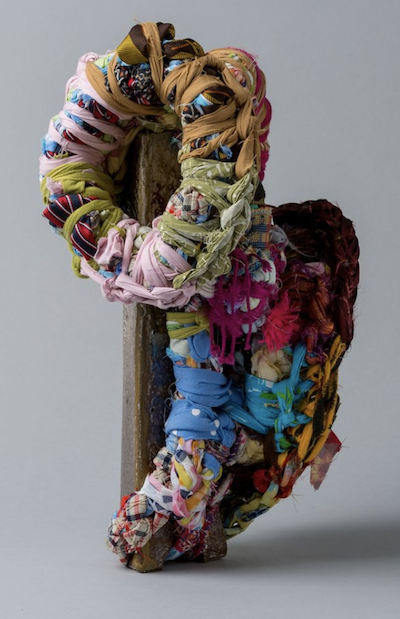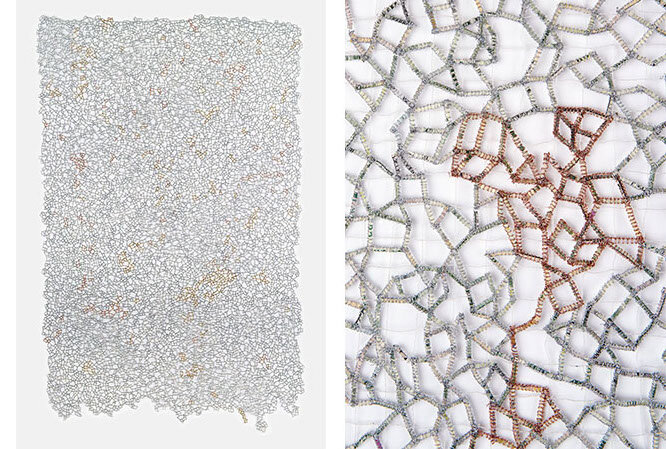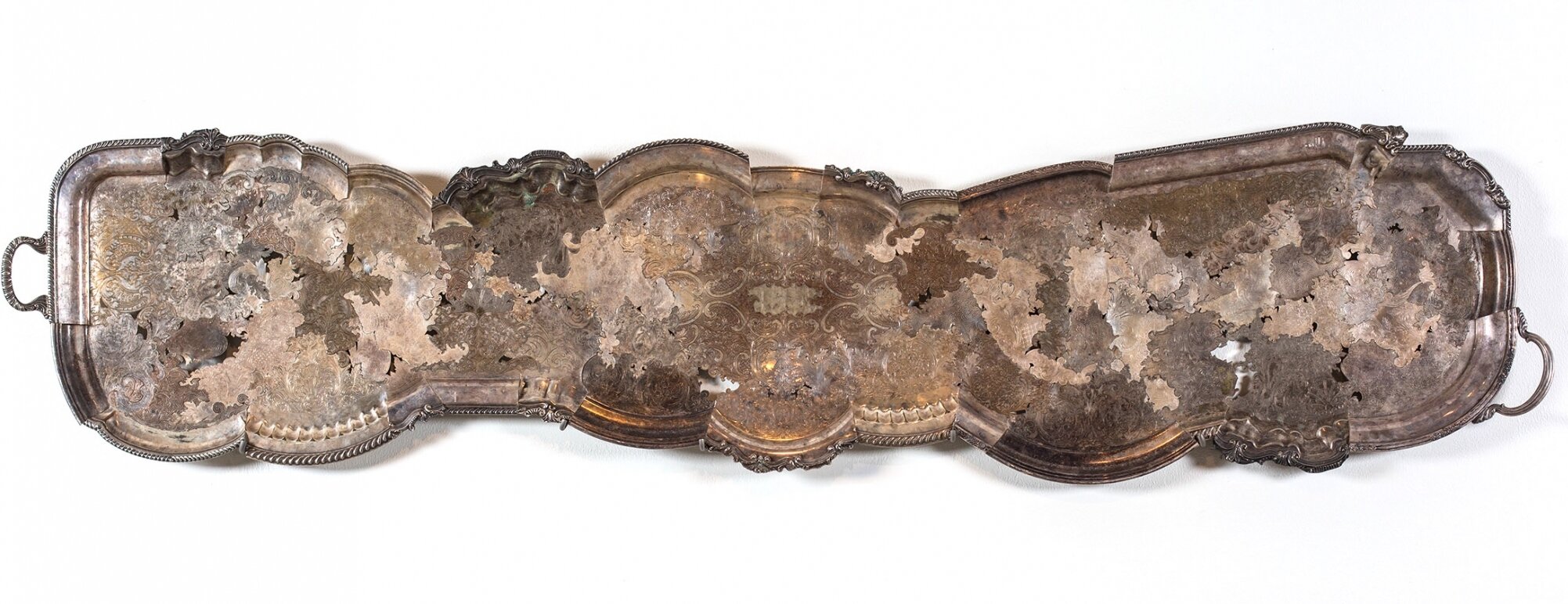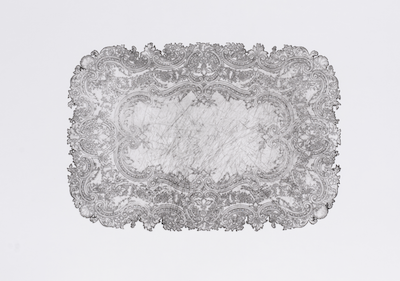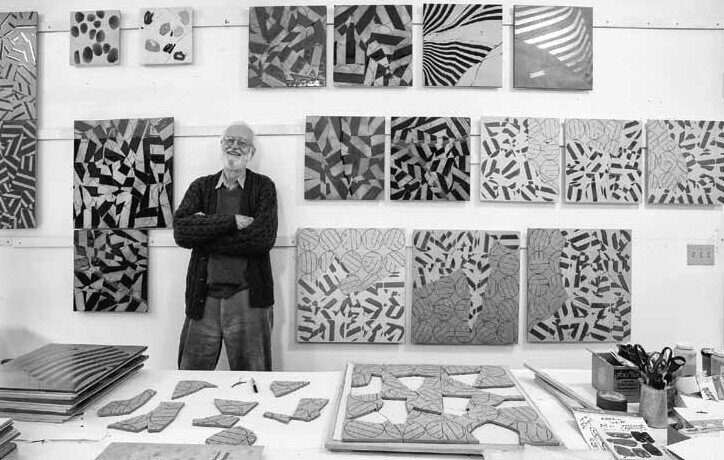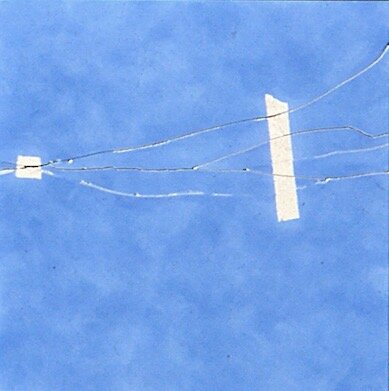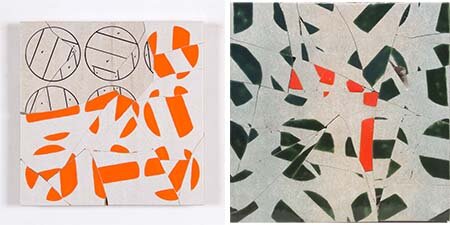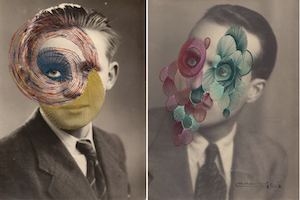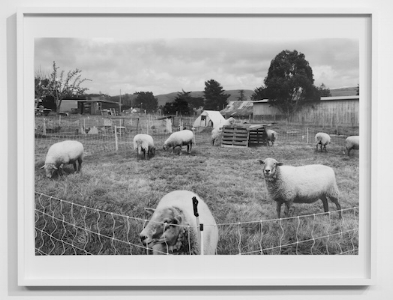Ramekon O'Arwisters: A Ministry of Mending
I.
My trajectory has been one of mending. By mending myself, I mend others. Looking at my history in a positive way calms me, and I can bring that to others. How do I mend my pain, my history? That’s work that most people don’t want to do. They would rather do anything else… --Ramekon O’Arwisters
After many months of thinking about repair in all its forms: actual and metaphorical; hidden and visible; social, artistic and psychological—the world has changed around me, both suddenly and gradually, in ways that seem both irreversible and incomprehensible. Trying to make sense of it all has meant circling back to the same questions with which this project first began. Who is mending for? Is it for the mender, for the recipient -- if that person is someone other than the mender—or for society as a whole? How important is the mender’s intention, even if that is kept a secret? How much do we need to know to understand what is being fixed, and what the nature of that mending really is? And, above all: I find myself asking, is mending important now?
When I first encountered Ramekon O’Arwister’s work, I was thinking about many of these questions—in part, because of the complicated and multidimensional nature of his practice. He is widely known in the Bay Area for bringing groups of people together in shared creative activity. Increasingly, however, it has been his mesmerizing, idiosyncratic textile and ceramic sculpture that has been getting attention. Both kinds of work involve not only physical mending practices, but spiritual and psychological repair as well.
O’Arwisters (his ‘artist’s name’: more on that later) has lived in San Francisco since the early ‘90s, but was born and raised in North Carolina. An articulate and charismatic storyteller, he has often spoken about his early life and its influence on him.
“I grew up black and queer, in the de facto segregated Jim Crow south of the ‘60s and ‘70s. It was a very angry and homophobic environment. My grandmother, who was born in 1898 and lived to be almost 87, had seen quite a bit, and understood who I was even before I did. One day, when I was very young—maybe 8 or 9— she said to me, ‘Come here, boy, and help me with this quilt. You can add any color or pattern you want. And I’ll show you how to add it.’
She already had a pattern; she’d been working on the quilt for months. But she was speaking to me in a symbolic way—the depth of her ability to do that was enormous. She couldn’t control what was going on outside of the house--- the racism, the homophobia—but she could help me calm down, to feel accepted and embraced and then go out and find positive solutions.[1]”
O’Arwisters’ parents worked in the textile mills, doing jobs that have now gone overseas. The family lived on a farm, raising some of their food, and he remembers both of his parents taking what they had and recycling/ reusing it creatively. “My father would say, ‘we aren’t going to go buy a new product at the store. We’re going to use what we have and repurpose it. We will improvise.’ To do this, you have to be in tune enough with your environment, see the links, be in the in between of things.”
Clearly, O’Arwisters’ education in the traditions and practices of Black culture was extraordinarily rich, but he didn’t have an opportunity to study art in school. College culminated in a Bachelor’s degree in psychology and sociology. Then, a few years later, he completed a Masters of Divinity , which usually leads to a career in the ministry. But art was always a part of his life; as a child, he had spent many hours sitting at the kitchen table, drawing and painting. “My parents knew that if I was drawing at the table, I’d be okay. I was at home, I wasn’t running in the streets, confronting the police, being destructive to myself or others.” Still, such an activity wasn’t considered to be work that someone could do for a living.
When he started in the master’s program at Duke University, O’Arwisters thought he wanted to be a preacher, or a pastoral counselor. “But I didn’t feel authentic in the church. I wasn’t ‘out’-- and the church wasn’t embracing gayness. How authentic could I be under those circumstances?” After graduate school, he spent five years in Japan, figuring out what came next. He taught English and, in his apartment, made colorful abstract drawings, showing and selling them in a Tokyo gallery.
When he returned to the United States, he moved to San Francisco, where he worked in various curatorial posts, eventually serving as the photography and video curator for the city’s airport. He was also making paintings, but “there wasn’t much happening with my art career.” Galleries weren’t interested. “I thought, there could be many factors here that are out of my control… I could be angry, but anger is not redemptive unless you can learn something from it.
“I thought, what am I angry about? I realized that I wanted a community, I wanted to be embraced, to be heard, to be accepted there on my own terms. So -- instead of asking other people to give me that, why not dig deep inside myself and cultivate those attributes inside of myself, give those things to others, through the folk art tradition my grandma had taught me? Instead of me wanting other people to accept me and my art, why not use the folk art tradition that my grandmother had helped me to experience—a tradition that had always been there in my life, but until I took the time to step back and reflect, I couldn’t see?”
But the kind of craft O’Arwisters had learned from his grandmother was needlework. That unfortunately made it inappropriate for a group activity-- since needles, after all, are sharp and tiny, and sewing is a skill that takes some time to master. O’Arwisters described to me the lightbulb moment when he realized that there was a practice he could share with others. “I showed my work to one of my friends, and she said, ‘you’re braiding fabric and sewing the braids together to make rag rugs, but you can do this with crocheting.’ That was the answer. I designed some bigger crochet hooks… and that allowed me to take it to another level--to use fabric, in a context that was healing.”
In 2011, inspired by his childhood experience of love and acceptance through making, O’Arwisters started Crochet Jam. As his story suggests, the participatory events he presided over were at least in part for himself: something like the way younger artists—especially artists of color and women-- sometimes create their own exhibition spaces or stage events, out of frustration with the hierarchy and (white, male) exclusivity of the art world. Over the months and years, O’Arwisters’ ‘Jams’ have taken place all over the country, at senior centers, elementary schools and community colleges; maker fairs and art fairs; in corporate headquarters, alternative art spaces, artist’s studios and museums; at shelters, during block parties and as part of neighborhood festivals.
Fabric, he has pointed out, is something with which we all have an intimate and constant relationship, from the moment we are born. It is familiar and comforting, talismanic and protective. Everyone knows it and feels comfortable with it—unlike fine art materials, which can be intimidating. “I’m asking participants to look at making differently—to make without a label, to allow themselves to just experience it. I ask them to just accept what they are doing. Just to do it, not define it. I don’t want to be defined myself—politically, sexually, racially. We are more than our labels. I don’t expect the participants to go that far, but I want them to just choose their fabric and interact with it. I don’t give them instructions. I let go of my authority and allow them to maintain their agency.”
At the same time that hundreds of participants have ‘jammed’ with him all over the US, O’Arwisters gave himself the same kind of permission and encouragement, developing a new way of making sculpture. It started when he was doing a residency at Recology— the San Francisco dump— in the fall of 2016[2]. During the initial weeks, he went into a frenzy of collecting, picking through the astonishing wealth of material brought back to the transfer station by the city’s garbage trucks. The discards he found included everything from tires and hubcaps to typewriters, bathtubs, and old medical textbooks, and he filled his studio.
After three months of this, Deborah Munk, the director of the residency program, walked into his space and remarked that it looked more like a yard sale than art. She reminded him that visitors would be coming to see his work in a month, and asked him what his concept was. “I went into panic mode,” he recalled, “because she was right-- a month isn’t a long time to organize a show that is going to get a lot of attention, which these residency shows usually do. So I decided to reflect, step back and see how I was feeling on the inside.
“This was 2016, remember—the election had taken place during those months. I felt broken, detached, thrown away, sharp—so I took these emotions and feelings, accepted them, and thought, OK—instead of just looking at this as an opportunity to accumulate, I’m going to look at it as a way of reflecting these emotions. Whatever I’m feeling, I thought, maybe others are too.”
O’Arwisters put on the safety suit artists are required to wear in the delivery area and stepped into the space. “At first I saw the usual stuff I wanted to drag to my studio. I thought, this isn’t really working… Until suddenly I heard a crashing sound, four or five bins down from where I was standing. So I walked over there and I was staring at broken ceramics.
“Someone had cleared out their family heirlooms, or they just wanted to get rid of some stuff—plates, bowls, teacups—and I’m just standing there, looking at these broken, sharp things—and I’m misty-eyed. And I thought, ‘Ohhhh… I need medication… counseling… something.” O’Arwisters smiled when he told me this part of the story, but it was clear that he was serious at the same time. “Then I thought, If I’m looking at shards and I’m emotional, it must be something in the unconscious I’m dealing with. They’re broken. And that’s how I feel.’ So I picked them up and brought them back to my studio, and I started making work.”
At first he put the shards in frames and various other containers, presenting them that way in his Recology show. Later, though, he wondered what it would look like if he drew on his experience with crocheting and put these very different materials together: strips of cloth, something as familiar to him as breathing, and the hard, brittle shards that represented how he was feeling. The crocheted fabric could frame the broken bits, in a kind of bricoleur’s repair. He called the series Mending.
In these tabletop sculptures and wall pieces, fragments of mundane, every-day ceramics—some small, and others quite large-- are cradled and contained by eccentric crocheted forms. The ropy coils of cloth wind around the sharp, broken bits like shapely bandages, inside of which the lip of a cup or rim of a bowl can be seen. It’s a kind of aid that holds a hurt without trying to conceal it. Not completely, anyway. Mending #21 brings to mind the way a tree grows around a fencepost or sign, engulfing it in living wood: a process called inosculation. The word suggests an enveloping kiss.
The fabric forms are composed of a wild variety of colors and textures. (He originally bought old clothes, linens and yard goods at thrift stores, but now, people give him bags of these materials. A stockpile of fabric is constantly being used and replenished during the ‘Jams.’) The shapes of many works invoke vessels, but some are more abstract. In Mending # 19, for instance, crocheted curves and circles envelop a tall, narrow vase, like vines overgrowing a neglected monument. And each work changes radically when viewed from different sides. In Mending #16, the swags of material wound around a broken bowl alternately reveal and conceal the ceramic form, almost coquettishly.
Talking about his choice of materials, O’Arwisters told me that it had to do with both past and present. “I needed to accept my journey as an artist—my journey, not a Western European journey, involving painting on canvas, or working with marble in a specific fine art tradition—those things don’t speak to my experience. It’s like me trying to put myself in a context that doesn’t reflect the authenticity of my world. My grandmother, my mother—they both reflected their joy or pain through fabric.”
Mending # 18, one of the least vessel-like pieces, is also one of the most idiosyncratic—and turns out to be predictive of the direction O’Arwisters work has taken. Jagged fragments of plate support the sculpture’s nest of cloth. Wider than it is tall, it suggests a giant knot perched on dainty sharp feet. Other shards of ceramic protrude from the surface: as if the act of crocheting, like a geological process, had broken a vessel into bits, that now rise to the multicolored surface.
_______________________________
II.
Everyone has a primal connection to shards. It’s different from broken glass-- a different emotional connection. --RO
Like cloth, pottery goes back to almost the beginning of human culture[3], and has been part of the domestic landscape of nearly all peoples. Sometimes more than once, civilizations all over the world figured out how transform mud into something permanent. At least, until it breaks.
In O’Arwisters’ work since early 2019, both textiles and ceramics are still present, but their roles and behavior have changed in subtle yet important ways. Gradually, he has moved from using one or two shards in each sculpture to incorporating as many as he can. These are no longer the shattered remains of domestic pottery, though, but come instead from a collaboration with the ceramics department at California State University, Long Beach. The faculty, staff and students of this well-known program make ambitious, eccentrically- glazed sculpture and one-of-a-kind tableware. Sometimes pieces have mishaps, blowing up or breaking in the kiln, and end up in the department’s ‘shard yard.’ From pictures of these interesting failures, O’Arwisters chooses the ones he wants, paying for them to be packed and shipped to him.
In his current series, called Cheesecake, these broken pieces[4] are startlingly visible, their dagger-like forms thrusting out like limbs in all directions. Often covered in some strange texture, they have a presence that lies somewhere between alien and ancient, like some of the imagery associated with Afro-Futurism.
O’Arwisters chose the title Cheesecake because he means this body of work to be provocative and sensual—but slightly disturbing, almost threatening, as well. For him, this dichotomous combination encapsulates the way he feels about being a queer black man. Historically, he reminded me, black men are perceived as dangerous[5]. He remembers being raised to be passive and submissive. “You never looked white people in the eye. Even now, I wouldn’t make eye contact with the police… How do I make my work reflect my experience? How can the materials I use be subversive, sensual, powerful and restorative, all at the same time?”
The cloth in these works is different too, both in its deployment and presence, and in that it new instead of recycled. O’Arwisters is using fashion fabrics he buys online from a store that specializes in designer material[6]. While not necessarily more vivid, these offer a dizzying variety of textures and weaves. In addition, he has started plaiting the cloth as well as crocheting it. (Braiding was a daily ritual in his childhood home, as it is in many African American households; a number of Black artists have made potent and compelling work about and with hair[7].)
In several works, skeins of loose threads and what look like tassels hang and drape, sometimes cascading over the sharp edge of a glazed fragment. Many of these suggest the possibility of a figure, costumed in some kind of ceremonial regalia.
Cheesecake #10, in contrast, looks more like a ceremonial weapon, the cylindrical void at its center ready to receive a pole or spike.
Or, maybe, it looks like-- nothing else. There are slight familial resemblances to other art or artists. Nick Cave’s sound suits, Meschac Gaba’s human-scaled versions of iconic buildings made from braided hair, or Judith Scott’s thread constructions could all be distant cousins of these pieces. But, as O’Arwisters once said to me: “When I’m working, I hear a voice saying, ‘don’t worry about how it looks,’ and I think, who’s talking? Then the voice says, ‘Accept it as it is.’ And it makes it possible to make things I haven’t seen before.”
If the Mending series alludes a kind of gentle spiritual repair for viewer and maker alike, O’Arwisters seems to intend the Cheesecake pieces to be sharper—not only literally (he has learned to use tape towrap the edges of the shards while he is working, which can have razor-like edges) but metaphorically. They are both frightening and beautiful: a quality that eighteenth century philosopher Edmund Burke ascribed to an artistic effect productive of the strongest emotion the mind is capable of feeling, writing, “Whatever is in any sort terrible or is conversant about terrible objects or operates in a manner analogous to terror, is a source of the sublime.[8]”
Can something that inspires awe and fear be reparative? Maybe. Art can call attention to the need for mending in many different ways. In the future, O’Arwisters intends to make his pieces larger, so that their meaning/ feeling is more clear. “I am planning to make work that, instead of looking down to see it, you have to look up, and walk around it. Something that’s as big or bigger than we are. Where fabric doesn’t look like fabric anymore. I think about how water can be transformed to ice, or steam. I’ve wondered how I as an artist could be so in tune with my materials that I could make them behave, make them appear like other materials. I want to know my instrument like a jazz musician, so well that I can improvise with it. To become the conduit for what the material wants to become.”
____________________
III.
My job is not to pass my pain on to you, or anyone else. What I’ve learned is that when I am calm, I can make decisions that allow me to navigate in a positive way. How do I help others to do that?-R.O’A.
At the end of our first visit, I asked O’Arwisters about his name. He told me that he had needed to change it to be who he wanted to become. “My birthname came out of the Judeo-Christian heritage. No one expects much from a name that’s so common-- Timothy-- and I needed a name that would change my posture: that would put me in the world with confidence, in opposition to that heritage.
“My father, whose name was Arwisters, never mistreated me for being a gay child. Some men would have been embarrassed by my ways, my voice. As I got older, my dad never minded when I brought my boyfriends home. He would even show them around town! In the black church, the whole idea of gay and lesbian culture is still very unaccepted. So I took his name to remind me to have that kind of compassion. I added the o in the Celtic tradition, in which it means ‘child of.’
As for my first name, I think the word ramekin- the cooking dish-- is such a beautiful word. But I knew that if I spelled it that way it would confuse people. So I changed the spelling. You can’t dismiss it—it’s powerful. Ramekon.
“It’s through my work that I can be that person—be the most authentic, the most honest. That’s very important to me, that I am able to accept my journey as I am. Every day, I’m working with broken ceramics. And when people look at it, they see that the shards aren’t being thrown away, but embraced. Held firm. We all feel broken sometimes. We want people to mend us, hold us in their embrace. Come visit us when we’re feeling well, write a note. Hold our hands. Hear, without interrupting. Actually listen. It’s a gift to be heard. I do the best job I can.”
_________________________
Notes
[1] All quotes from Ramekon O’Arwisters are from conversations with the author.
[2] The San Francisco dump, aka. Recology, hosts a highly competitive and coveted artist’s residency, during which artists have a studio for four months and access to whatever the garbage trucks bring back to the transfer station: https://www.recology.com/recology-san-francisco/artist-in-residence-program/
[3] 26,000 BCE. http://www.visual-arts-cork.com/pottery-timeline.htm
[4] Like Jim Melchert, O’Arwisters further breaks pieces at times to get more interesting shapes.
[5] Or not so historically: Ahmaud Aubrey.
[6] Mood Fabrics has stores in LA and NYC, and the most extraordinary website: https://www.moodfabrics.com/fashion-fabrics/designer
[7] This subject is too large to address so briefly, but here are some artists and exhibitions: http://sonyaclark.com/medium/hair/
@Laetitiaky on Instagram makes astonishing sculpture out of her own hair.
African sculptor Meschac Gaba: http://www.tanyabonakdargallery.com/exhibitions/meschac-gaba/selected/2
https://www.vice.com/en_us/article/ywgq4j/9-artists-explore-black-hair-barbershop-culture
[8] https://www.tate.org.uk/art/art-terms/s/sublime









